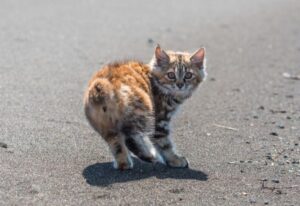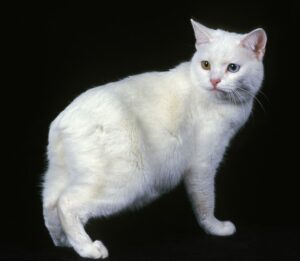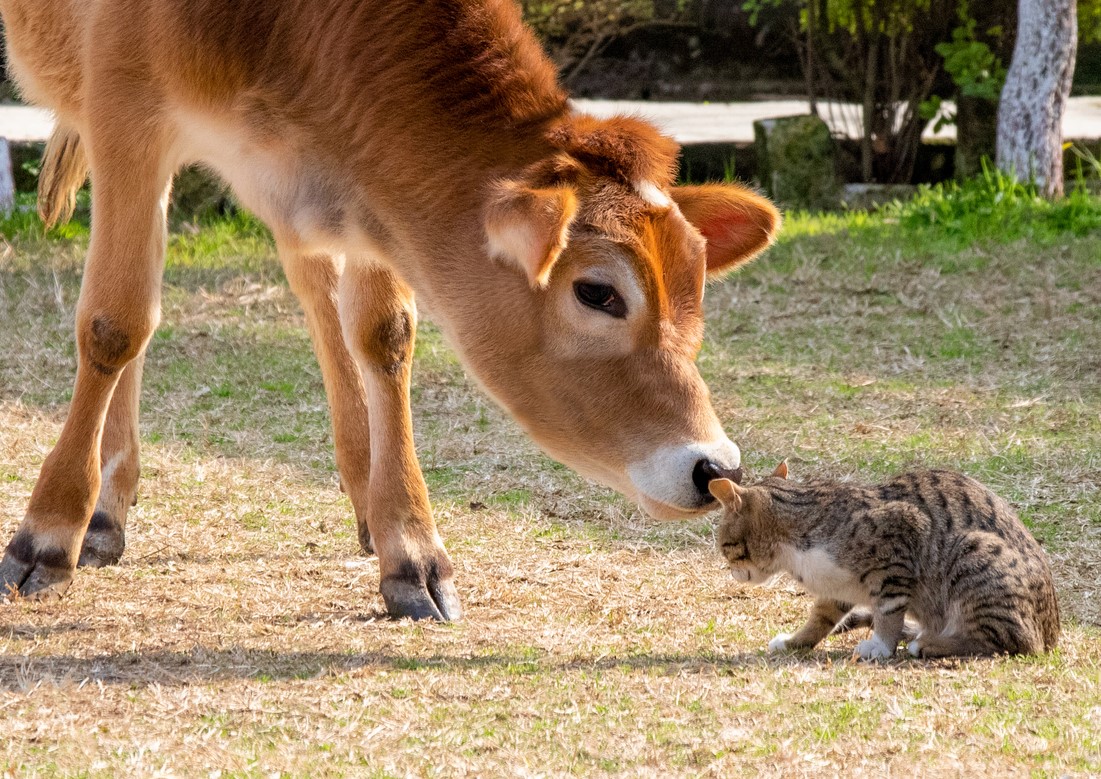Most cats have long and elegant legs, and they appear very regal when they walk. Hence, the phrase, ‘catwalk.’ But, if your cat’s hind legs are not straight, then your cat might be cow-hocked. And no, this doesn’t really have much to do with actual cows.
So, what is a cow-hocked cat? Cow-hocked cats suffer from a physical deformity where the hind legs bow toward each other so that the cat’s hind legs resemble the body structure of a cow. The condition is sometimes referred to as x-legs.
Being cow-hocked can be a harrowing experience for your kitty cat, as it doesn’t just affect their outward appearance. The older your kitten gets, the worse the pain can get for your cat. Moreover, the deformity can also lead to spinal issues and an awkward gait.
So, let’s take an in-depth look at recognizing the symptoms of a cow-hocked cat and find out how best to care for one. You will also discover some of the precautions you can take to prevent future kitties from being cow-hocked.
How Do You Know If Your Cat Is Cow-Hocked?

A cat’s back legs should be pretty straight from top to bottom. It’s not rocket science to figure out whether or not your cat is cow-hocked.
But, if you are having a tough time figuring out if your cat’s legs are just a bit off-set or they have a serious condition, you should take a close look at your cat from the back.
It would help if you did not try to identify whether or not your kitty is cow-hocked from the side or the front, though it can be seen from these angles to the trained eye.
You will need to check out the curve of the legs and take a good look at your cat’s feet. The tell-tale signs are outward facing paws and inward facing heels.
What Are The Symptoms Of Your Cat Being Cow-Hocked?

Cats are often cow-hocked, and a case of mild cow-hocking is often negligible. Most kittens seem to be cow-hocked until they grow older and their limbs become linear.
The most obvious sign of cow-hocking is the visible hind legs angling inward, and the feet splayed more outward. However, when a combination of cow-hock and sickle-hock (ankles rounded instead of straight) exists, the symptoms become more severe.
Many cow-hock symptoms in a cat tend to become more pronounced as your cat gets older.
Some of the consequences of cow-hocking in a cat are:
- Clumsy gait
- Early-onset of arthritis
- Damage to the spine
- Inability to adequately defend against predators
- Inability to walk fast or even run.
Are Cow-Hocks In Cats Dangerous?
Cow-hocks in cats aren’t just a visual deformity. It is a genetic misalignment of the hind leg joints. In most cases, cow-hock is nothing more than a goofy-looking flaw in your kitty. But, cow-hocking falls on a spectrum, from slightly visible defect to acute spinal disability.
Arthritis
In young or mature cats, the issue of cow-hocking isn’t as problematic. However, when kitties get older or obese, ‘x-legs’ can become debilitating. One of the most significant complications of this deformity is arthritis. Arthritis is a common problem in aging pets, but arthritis can make an early appearance in cow-hocked cats. The severity of this crippling ailment can be harsh.
Cow-hocked cats with arthritis often suffer from swollen, painful joints. These cats have problems walking, standing, and jumping. Your kitty cat might start with a slight limp, but it may end with permanent lameness.
Your cat may experience stiffness in the legs, suffer from irritability, exhibit abnormal levels of aggression, spend less time grooming, be less active, and spend more hours sleeping or hiding.
Once your cat does get arthritis, hurting their joints and bones from the slightest movements becomes a real possibility. Cats with arthritis get more fractures and injuries than healthy cats as well.
Spinal Damage
As mentioned earlier, when cats are cow-hocked, their hocks are literally close enough to touch each other. Such a state over a long period can damage your kitty’s spine. Your cat might suffer from uncoordinated movements and minor muscle spasms. It may start with tense muscles or an odd posture, but spinal damage can result in lameness in the long run.
Weakness, incoordination, numbness, loss of bladder or bowel control, extreme back pain, and pressure on the neck are just some of the many signs of spinal damage.
How To Fix A Cow-Hocked Cat?
There’s no known cure to fix a cow-hocked cat. Since a cow-hock is a genetic irregularity, you can’t simply suppress or cure the deformity with medications. However, there are medicines that veterinarians do offer to older cow-hocked cats with arthritis.
A cow-hocked cat suffering from arthritis as well may suffer from significant pain. But, the proper medicine can ease your pet’s pain and make life more comfortable for your beloved pet. Furthermore, vets often recommend pet parents of cow-hocked cats to keep their kitties indoors away from predators and preventable injuries.
It would be best to be very careful about a cow-hocked cat regarding their diet and weight. Cow-hocked cats can’t afford to put excessive strain on their spine, back, or hind legs. So, you need to ensure that if your cat is cow-hocked, you should keep a close eye on their diet and keep their weight at the optimal level.
You can add specific supplements to your cat’s diet that will work wonders on your pet’s joints. If you own a cow-hocked cat, you should get in touch with the local vet and get them to prescribe supplements for your kitty. Naturally, the supplements will not correct the cow-hock problem. But, it will give your pet’s joint health a boost and prevent the deformity from causing excess pain or discomfort (we’d recommend this brand).
What Form Of Exercise Will Help Your Cow-Hocked Cat?
Believe it or not, there are even specialized exercises that you can plan out with the vet for your cow-hocked cat. These exercises are essentially made to help ease any pain that might arise due to the deformity and somewhat realign the hind legs with slow yet routine exercise.
There are many forms of exercise, and exercise is a sure-shot way to help alleviate some of your cat’s pain as well as strengthen their joint bones.
- Belly Rub – Make your cat lie down on their back and rub on their belly. Hopefully, the belly rub will get your cat to shift their weight from side to side and strengthen their core muscles.
- Kneading – Gently rolling and pinching the cat is called kneading. This form of exercise promotes circulation and blood flow all over your cat’s body. And kneading at your cat’s back and neck will also help release some of the stress that develops as a natural consequence of the pressure that builds up due to being cow-hocked.
- Happy Butt Rub Dance – Vigorously rub at the top of your cat’s rear-end. Some cats find this exercise stimulating and shift their weight from side to side, providing relief to the aching back as well as the cat’s legs and paws.
- Stretch On The Couch/Chair – While sitting on a chair or couch, have your cat’s hind legs on the sofa and lift or raise the front legs by placing a cushion or with your hands. It would be best if you can get your cat to stay in such a position for at least two minutes. Repeat this exercise at least twice a day. This exercise helps improve rear leg weight-bearing/strength, range of motion, and hip extension.
- Wheelbarrow – By lifting the cat from the abdomen and raising the hind legs, you will be able to strengthen the forelegs of your pet. Please do not use your pet’s hind legs to raise their body, and you need to remember to support the abdomen. When you want to strengthen your hind legs, use the abdomen to lift the front legs and make your pet walk on their hind legs. Also, start with a stationary position, and once your pet is comfortable, you can encourage them to take a step forward or backward.
- Bootie On The Paw – you can place a bootie or scrunchie on your pet’s paw. The moment you get the bootie on, your kitty will undoubtedly try to get it off by shaking their paw. The process of shaking their paw will help your cat with their weight-bearing. You can repeat this exercise with all of their paws.
- Rock On – Encourage your cat to walk on uneven surfaces such as cushions, pillows, foam mats, balance trainers, or a bed. Your cat will automatically shift their weight to balance themselves. This exercise will strengthen your cat’s legs, coordination, flexibility, and proprioception.
- Beg With Weight Shifts – Use a healthy and delicious treat and lure your cat to stand on their hind legs. You can lure the cat’s head up as far as it will go and keep that position for a while. But, if your cat truly loves the treat, they will stand up on their back legs. To make the exercise more challenging, move the treat from side to side, and your cat will follow the movement. This exercise is for core strength and is meant to improve your cat’s coordination and joint health.
- Contralateral Limb Lifts – While your cat is standing, lift your cat’s front left paw and raise your cat’s right hind leg simultaneously. Hold the position for a few seconds and repeat on the opposite side.
These exercises aren’t going to cure your pet of their x-legs, but they do go a long way in keeping your pet’s joints and bones strong. Furthermore, some of these exercises work on your cat’s muscle and skeletal structure, and a daily effort from you and your pet will help your cat in terms of soothing their pains, stress, and tension in their tiny body.
How Do Cats Become Cow-Hocked?
Well, you know that it’s all about genetics when it comes to cow-hocking. This deformity is something that kittens get from their mama and daddy kitties. There’s no way that you can curb this deformity with any medication or vaccine.
It may be relatively easy to tell if a cat is cow-hocked or not when dealing with an adult cat. But, when dealing with kittens, there’s no guarantee whether your kitty will be cow-hocked. There’s no saying that the kitten will be cow-hocked even when the kitty parents are cow-hocked.
Cute little kittens tend to have tiny, bendy hind legs anyways. So, if you want to be sure that your cat is cow-hocked, you will have to wait a while longer till your cat is an adult.
Can All Breeds Be Cow-Hocked?
There’s no definite scientific research to prove or disprove whether or not all cat breeds get cow-hocked, nor is there evidence to support the claim that some breeds of cats are more cow-hocked than others. There is an obvious need for more scientific study as well as research.
But, there is a simple solution to limit the genetic spread of cow-hocking. Breeders and cat owners need to restrict the breeding of cow-hocked cats. As you might already know, cow-hock cats pass their genes down to their litters. But not every kitten from a cow-hock cat parent will be cow-hocked also.
However, when you restrict entirely the breeding of cow-hocked cats, you can safeguard the future generations of kittens-to-be from being affected by this deformity. With cow-hocking, the gene can go dormant for some time, which means that a few litters of kittens will escape the genetic misalignment. And when the gene becomes active, the deformity will reappear in later litters.
Why Is My Cat Walking On Their Hocks?
Cats tend to walk on their hocks when they want their pet parents to know that something is wrong, or even when walking is typically too painful for them. It’s your job as a pet guardian to keep a close eye on your pet’s nuances, and if you can see that your pet is exhibiting behavior out of the ordinary, you should investigate the root of the problem.
The hock is the extra joint-most animals have at the back of their hind legs. It often looks like a different knee or heel at the back of your pet’s hind legs. Your cat will revert to walking on their hocks when they are feeling sore or finding it difficult to walk in a straight gait.
Another situation where you might find a cat walking on their hocks is if your cat has diabetes. Diabetes causes an early onset of deteriorating bone health. The more painful it becomes for your cat to walk in a regular way, the more likely they will walk on their hocks.
A vitamin deficiency or even an injury can induce your pet to walk on their hocks as well.
Final Thoughts
Having a pet as intelligent and affectionate as a cat is a privilege. There’s no doubt that your beloved pet will bring much joy and happiness into your life. But, being a pet parent is also a huge responsibility. It is a responsibility that most pet parents need to be quite serious about. Having a cow-hocked cat doesn’t necessarily mean a pet with a disability.
It’s likely that your cat may be cow-hocked, but it is just a visual disformity. In such a case, a lot of love and care, extra attention to your pet’s diet and weight, and some exercise will be all the help your pet will need to live a long and happy life. However, if your cat is cow-hocked and suffers from associated health issues, then you need to be very vigilant about your cat’s needs and wants.
The one thing that all pet guardians of cow-hocked cats need to keep in mind is that being cow-hocked is a genetic ailment that cannot be treated or cured so, the only way to ensure that your future pets do not suffer from a similar circumstance is to get your cat spayed or neutered.
You should know that you wouldn’t be hurting your pet in any way by doing so. You’d be safeguarding the future of many adorable kitties.
Up Next: How To Use Olive Oil For Cat Dandruff
